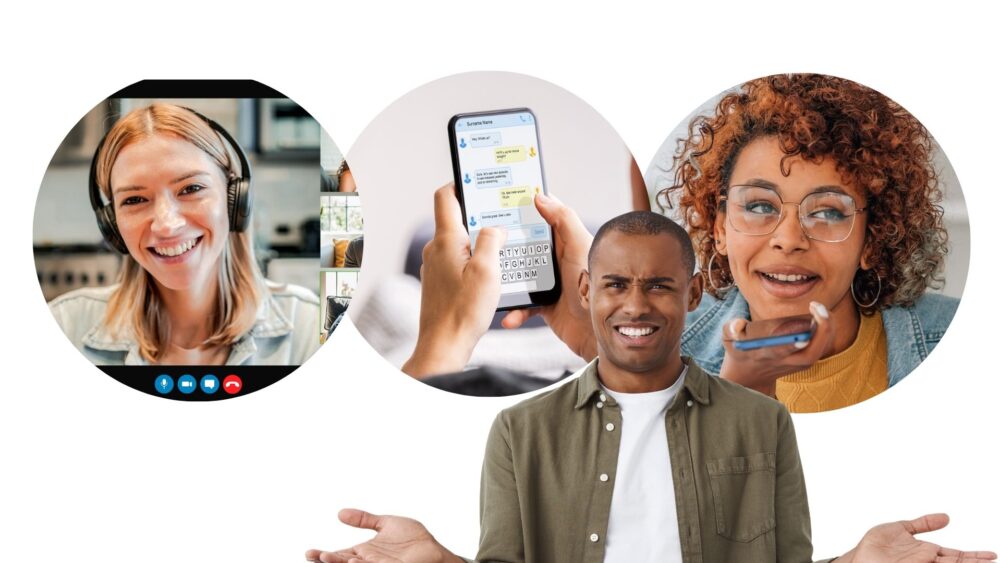KEY POINTS
- Video calls create the strongest sense of presence but can increase self-consciousness.
- Audio calls allow for spontaneous, deeper conversations with less pressure.
- Texting maintains an ongoing connection but doesn't replace real-time conversations.
- The key to strong friendships is finding ways to connect that feel natural for both of you.
Valentine’s Day seems like a good time to talk about social connection. A lot of things influence how we like to connect with others, from personality and context to the closeness of a relationship. Our formative years also affect what we view as normal, anchoring our perspective and creating an inherent bias in our worldview. We are conditioned to think about the world in terms of what we have, not what we don't have. Thus, we tend to measure any new form of technology as what it lacks relative to our perceived gold standard. This shows up in our reaction to technology use and the kinds of research questions that get asked (and funded).
We rarely approach new technology from the other way around—looking at what it can do that the offline world can't. Piskorski (2011) calls these instances where offline constraints prohibit desired social interactions "social failures." This is an elegant explanation of why social networks became so popular by taking limitations off the ability to be social. Social connection is a primary motivator of human behavior and essential to our well-being.
Nevertheless, we approach each new technology through the lens of our experience-based biases about what's normal, shedding light on why we may have a hard time accepting that others—especially those younger than us—have a fundamentally different experience with technology than we do. Especially when they embrace social interaction in a form that we "feel" must be inferior. Unquestioned assumptions can prevent us from asking where technology can enhance the quality of our lives and relationships.
This post breaks down the psychological strengths and weaknesses of video, audio, and texting as social connectors. Understanding where and why they might be used to bridge gaps when it's impractical or impossible to connect in person lets us be more intentional in how we can best achieve our relational goals.
Thanks for reading!
Before social media, maintaining friendships required direct communication. Social media has changed our reach by leveraging the time and effort needed to build social connections. While Dunbar's number says humans have a cognitive limit on the amount of stable relationships an average individual can maintain, social networks challenge that notion by enabling virtual connection. However, there remains a material difference between the strong ties of close friends and the weak ties facilitated by social media. It makes it easier to maintain meaningful connections despite geography and time zones but also expands the definition of "friends" to include people you used to know, people you kind-of know, or people you want to know.
Close, meaningful friendships require more care and attention than the ambient awareness of a Facebook friend or TikTok follower. Friendships thrive on consistent two-way communication that reinforces emotional bonds and trust and maintains closeness over time.
With letter writing largely outmoded for everyday communication, maintaining friendships means navigating digital communication: Text, voice, and video. But how do different tools impact our relationships? Do they all foster connection equally, or does one stand out as the best for maintaining strong friendships?
Each mode of communication engages the brain differently, influencing emotional connection, trust, responsiveness, self-disclosure, and relationship satisfaction. Understanding how video, audio, and text differ can help us be more effective in how we communicate meaningfully with friends and loved ones.
We're All Different
There are generational differences in how people prefer to connect, influenced by the technological environment each generation experienced during their formative years. Gen Z has grown up in a world where digital communication is always on, visual-first. They don't have to unlearn anything to be comfortable with frequent video calls or see them as a better substitute for in-person interaction than texts or voice. Many GenZers regularly FaceTime friends while doing homework, getting ready, or hanging out, making video calls an integral part of daily life rather than a formal event.
People vary widely in their ideal mode of connection. The key is communicating what feels natural for both people and finding a rhythm that strengthens the friendship without pressure or burnout. You may be an extrovert who enjoys frequent, spontaneous FaceTime calls and feels a bit ignored when a text gets a slow response. By contrast, your friend may feel under pressure with unannounced video calls and prefer the flexibility of texting. Figuring this out ahead of time can avoid many misunderstandings and hurt feelings.
Video Calls: The Power of Visual Connection
Video calls have become a staple of both work and personal life. Whether using FaceTime, Zoom, WhatsApp, or Snapchat, these platforms allow face-to-face interactions regardless of distance. But does seeing someone's face make us feel closer to them?
Benefits of Video Calls
✅ Nonverbal Cues Enhance Connection – Research shows that facial expressions and body language are crucial in communication. The human brain is hardwired to respond to faces, which activates our sensitivity to emotional cues like smiling, reinforcing trust and personal connection, and reduces the risk of misinterpretation compared to texting or voice calls.
✅ Mimics Face-to-Face Interaction – Virtual eye contact triggers the same neural pathways as in-person interactions, so when we see a friend's face, our brains release oxytocin, the "bonding hormone," which enhances trust and emotional intimacy.
✅ Encourages Presence & Engagement – Seeing another person's face increases focus, reduces multitasking and distractions, and makes conversations more immersive and meaningful.
Drawbacks of Video Calls
❌ Higher Cognitive Load – Video calls require more mental effort because the brain must simultaneously process visual and auditory cues, leading to increased cognitive load (Sklar et al., 2021).
❌ Zoom Fatigue & Social Pressure – Video calls require maintaining eye contact and being "on," which can be mentally exhausting. The prefrontal cortex, responsible for self-monitoring, is on high alert when we see ourselves on-screen, leading to self-consciousness and added stress.
❌ Logistical Challenges – Video calls require some basic tech skills (where's the mute button?), a stable internet connection, and a conducive environment, making spontaneous and casual calls more challenging. Getting a FaceTime call at inopportune moments can be stressful.
Audio Calls: The Intimacy of the Human Voice
Although voice calls lack visual cues, they remain a powerful tool for connection. The ability to hear someone's tone, pauses, and inflections can create a deep sense of presence, sometimes even more than video.
Benefits of Audio Calls
✅ Lower Cognitive Load & Deeper Listening - Without visual input, the brain only needs to process sound, making audio calls less mentally exhausting than video. Research suggests that when we focus only on voice, we become more attuned to subtle vocal cues, leading to deeper, more engaged conversations (Kraus, 2017).
✅ More Spontaneous & Less Social Pressure – Audio calls can happen while walking, driving, or doing chores and remove concerns about appearance, making conversations more relaxed and informal.
✅ The Brain "Sees" the Person Anyway – Even without video, our brain visualizes the person we're talking to, transporting us into the call. The auditory cortex and visual imagery systems work together to create a mental picture, which helps sustain emotional presence (Zatorre et al., 1996).
Drawbacks of Audio Calls
❌ Lack of Nonverbal Cues – Without facial expressions, it's easier to misinterpret tone or intent. Some people find it harder to connect emotionally without visual reinforcement, making voice calls feel less personal.
❌ Encourages Multitasking – Unlike video calls, people are more likely to check their messages or get distracted during an audio call.
Texting: The Silent Glue of Friendships
Texting is the most frequent form of communication among friends, especially for Gen Z (Pew Research Center, 2022). But does it truly maintain relationships, or does it risk making them feel superficial?
Pros of Texting
✅ Easy, Low-Effort Connection – Sending a quick text or meme can reinforce connection without requiring a time commitment. Frequency simulates intimacy by increasing the sense of presence. The lack of voice cues and facial expressions is often offset with emojis, GIFs, and punctuation.
✅ Asynchronous Communication – Unlike calls, texting doesn't require both people to be available simultaneously, making it ideal for busy schedules or people who prefer having time to respond.
Drawbacks of Texting
❌ Lack of Tone & Body Language – Text messages can easily be misinterpreted due to missing vocal inflection and facial cues.
❌ Can Feel Less Personal – While frequent texting maintains contact, if you use texting alone, it will not build emotional closeness like conversations in real time.
❌ Ghosting & Slow Replies – Unlike calls with immediate feedback, the receiver can interpret delayed or ignored responses as a lack of caring, creating anxiety or hurt feelings (Koessler et al., 2019).
Which Is Best for Maintaining Friendships?
The bottom line is this: Close relationships thrive on consistent and varied communication that includes frequent interactions and meaningful conversations (Hall, 2020). You can use:
✔ Video calls for deep, meaningful conversations and emotional moments.
✔Audio calls for quick, spontaneous chats with less pressure.
✔Texting for ongoing, low-effort "touches" between calls.
✔Be present no matter how you connect.
The best friendships aren't about which tool, call length, or frequency—they're about showing up in ways that feel natural and meaningful for both people. The "best" communication method is the mix that lets you be consistent enough to build and maintain trust and emotional closeness. But most of all, be present. Communication only works if you're paying attention, no matter what you use. Anything that distracts you from another person, whether multitasking while you're on a call, checking your messages over dinner, or letting your attention drift to a conversation nearby, will inhibit the development of closeness and trust and reduce the empathy and understanding your partner will feel.
References
- Hall, J. A. (2020). Relational maintenance in the digital age: A communication perspective. Human Communication & Technology, 1(1), 27–39. https://doi.org/10.31274/hct.11412
- Koessler, R. B., Miyata, K., & Yamada, M. (2019). The psychological impact of ghosting and slow replies in digital communication. Cyberpsychology, Behavior, and Social Networking, 22(8), 528–536. https://doi.org/10.1089/cyber.2019.0035
- Kraus, M. W. (2017). Voice-only communication enhances empathic accuracy. American Psychologist, 72(7), 644–654. https://doi.org/10.1037/amp0000147
- Pew Research Center. (2022). Teens, social media, and technology 2022. https://www.pewresearch.org/internet/2022/08/10/teens-social-media-and-technology-2022/
- Piskorski, M. J. (2011). Social strategies that work. Harvard Business Review, November, 117-
- Sklar, A. Y., Han, M. P., & Bailenson, J. (2021). Cognitive load in video conferencing: Why Zoom fatigue happens. Psychological Science, 32(10), 1724–1738. https://doi.org/10.1177/09567976211014298
- Zatorre, R. J., Halpern, A. R., & Bouffard, M. (1996). Mental imagery of musical timbre: Evidence from functional neuroimaging. NeuroReport, 7(4), 793–796. https://doi.org/10.1097/00001756-199603220-00026

 Dr. Pamela Rutledge is available to reporters for comments on the psychological and social impact of media and technology on individuals, society, organizations and brands.
Dr. Pamela Rutledge is available to reporters for comments on the psychological and social impact of media and technology on individuals, society, organizations and brands.